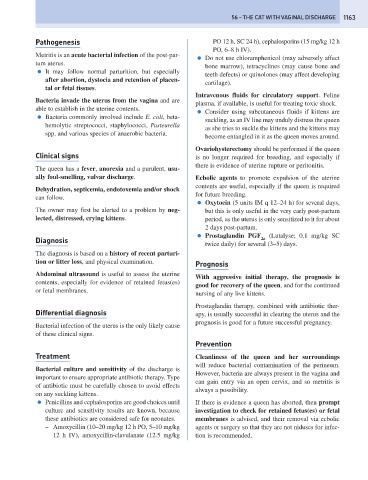Page 1171 - Problem-Based Feline Medicine
P. 1171
56 – THE CAT WITH VAGINAL DISCHARGE 1163
Pathogenesis PO 12 h, SC 24 h), cephalosporins (15 mg/kg 12 h
PO, 6–8 h IV).
Metritis is an acute bacterial infection of the post-par-
● Do not use chloramphenicol (may adversely affect
tum uterus.
bone marrow), tetracyclines (may cause bone and
● It may follow normal parturition, but especially
teeth defects) or quinolones (may affect developing
after abortion, dystocia and retention of placen-
cartilage).
tal or fetal tissues.
Intravenous fluids for circulatory support. Feline
Bacteria invade the uterus from the vagina and are
plasma, if available, is useful for treating toxic shock.
able to establish in the uterine contents.
● Consider using subcutaneous fluids if kittens are
● Bacteria commonly involved include E. coli, beta-
suckling, as an IV line may unduly distress the queen
hemolytic streptococci, staphylococci, Pasteurella
as she tries to suckle the kittens and the kittens may
spp. and various species of anaerobic bacteria.
become entangled in it as the queen moves around.
Ovariohysterectomy should be performed if the queen
Clinical signs is no longer required for breeding, and especially if
there is evidence of uterine rupture or peritonitis.
The queen has a fever, anorexia and a purulent, usu-
ally foul-smelling, vulvar discharge. Ecbolic agents to promote expulsion of the uterine
contents are useful, especially if the queen is required
Dehydration, septicemia, endotoxemia and/or shock
for future breeding.
can follow.
● Oxytocin (5 units IM q 12–24 h) for several days,
The owner may first be alerted to a problem by neg- but this is only useful in the very early post-partum
lected, distressed, crying kittens. period, as the uterus is only sensitized to it for about
2 days post-partum.
● Prostaglandin PGF (Lutalyse; 0.1 mg/kg SC
Diagnosis 2a
twice daily) for several (3–5) days.
The diagnosis is based on a history of recent parturi-
tion or litter loss, and physical examination. Prognosis
Abdominal ultrasound is useful to assess the uterine
With aggressive initial therapy, the prognosis is
contents, especially for evidence of retained fetus(es)
good for recovery of the queen, and for the continued
or fetal membranes.
nursing of any live kittens.
Prostaglandin therapy, combined with antibiotic ther-
Differential diagnosis apy, is usually successful in clearing the uterus and the
prognosis is good for a future successful pregnancy.
Bacterial infection of the uterus is the only likely cause
of these clinical signs.
Prevention
Treatment Cleanliness of the queen and her surroundings
will reduce bacterial contamination of the perineum.
Bacterial culture and sensitivity of the discharge is
However, bacteria are always present in the vagina and
important to ensure appropriate antibiotic therapy. Type
can gain entry via an open cervix, and so metritis is
of antibiotic must be carefully chosen to avoid effects
always a possibility.
on any suckling kittens.
● Penicillins and cephalosporins are good choices until If there is evidence a queen has aborted, then prompt
culture and sensitivity results are known, because investigation to check for retained fetus(es) or fetal
these antibiotics are considered safe for neonates. membranes is advised, and their removal via ecbolic
– Amoxycillin (10–20 mg/kg 12 h PO, 5–10 mg/kg agents or surgery so that they are not niduses for infec-
12 h IV), amoxycillin-clavulanate (12.5 mg/kg tion is recommended.

